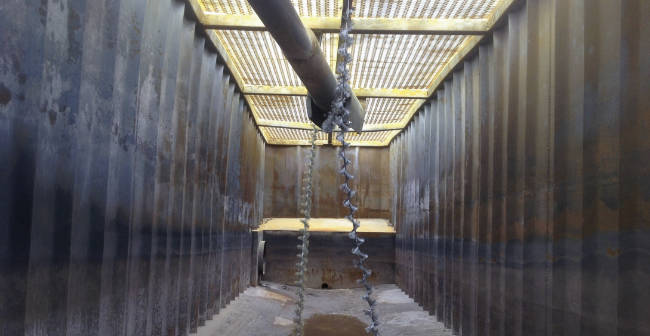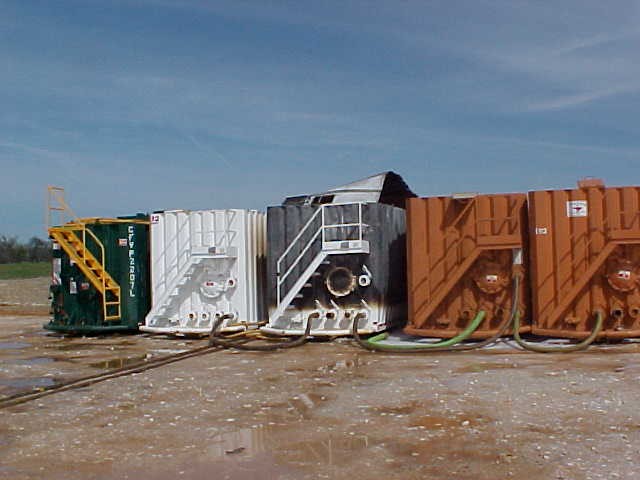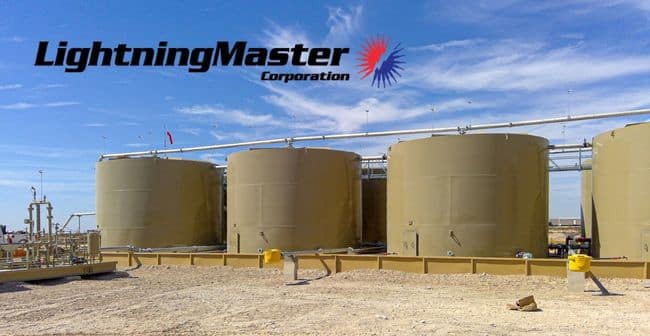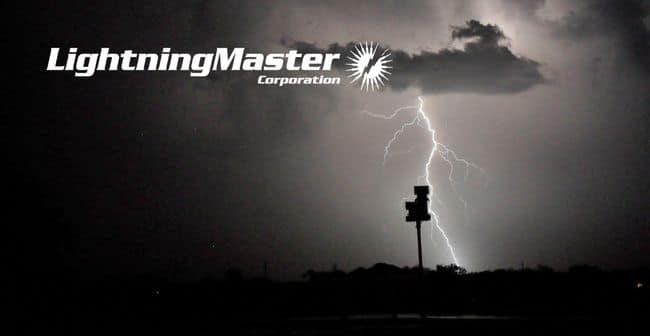[vc_row][vc_column][vc_column_text]Fires and explosions caused by static in flowback operations have become increasingly common. Let’s take a look at the problem and a readily available solution. Oddly enough, each operator with whom we have worked on this believes themselves to be the only operator experiencing it. We trust this article will both provide solutions and open communications between operators.
CONDITIONS NECESSARY FOR IGNITION
In order to have a tank explosion or fire resulting from static discharge, three conditions must be met:
- a static charge must be present and build to an incendive level
- sufficient voltage to arc
- sufficient energy to ignite
- a flammable mixture must be present
- there must be a source of ignition (arc)
Normal tank operations can create a static charge. Sustained operations in a standard tank with normal construction consisting of flat and large radius surfaces can allow the charge to build to a voltage sufficient to arc and to an energy level sufficient to cause ignition (incendive). The mixture in the tank changes with different types of operations, fluid constitution, fluid levels, etc., but can often be flammable. There are large radius edges on gussets, filler necks, and other fixtures within the tank that allows higher voltages to build up and to provide a target for arcing, the source of ignition. If all the stars and planets align just wrong, well, it just isn’t your day.
STATIC CHARGE
The fluid being pumped into a flowback tank is a combination of liquids, gases and suspended solids. As the unrefined oil component is fairly conductive and the mineral content may also be considered fairly conductive, the overall fluid may be fairly conductive. However, as it is pumped into a tank, it breaks down, producing small droplets that are suspended in the vapor space above the main body of fluid. As these particles separate out, and as they scuff against one another, the surfaces in the tank, and the surface of the stored product in the turbulence of the filling process, they accumulate a static charge. With the release of pressure, additional gases effervesce out of the liquid, adding charge. As operations continue, the charge accumulates more rapidly than it dissipates, allowing it to reach an incendive level. The voltage necessary to arc depends on the arcing distance, shape of the electrodes, and other factors, and the energy required is generally considered to be approximately 0.25 mJ to ignite an optimum mixture of saturated hydrocarbon gas and air.
FLAMMABLE MIXTURE
As the tank is filled, gas escapes from the fluid and rises to the vapor space, where it mixes with hydrocarbon particles atomized by the filling process. Filling an empty or almost empty tank is particularly problematic. When a tank is emptied, ambient air is sucked into the tank, so there is likely to be plenty of oxygen to support combustion. Additionally, as fluid is pumped into an empty tank it falls further and is not “cushioned” by fluid already in the tank, so it more readily atomizes, creating both an optimum atmosphere of small droplets and maximum static charge.
SOURCE OF IGNITION
Corona discharge takes place from small radius elements, such as sharp points and edges. It is simply ions being “pushed” by their surrounding charge off sharp points. The sharper the point, the more easily the ions leak off. This is a continuous, low-potential discharge, and the discharge produced is not likely to be incendive.
Brush discharge takes place off or to larger radius edges or points, generally 5-50 mm, such as a pipe, collar, gusset, internal ladder, etc. In order to make the escape from the flatter surface, the ions must be pushed harder by a greater charge potential. Rather than leaking off over time, they accumulate on the large radius edge until the potential is sufficient to push a large mass of ions off in an instantaneous discharge. This higher potential discharge may very well be incendive.
The larger the radius (or curvature) of an element, the more difficult it is for the ions to leak off, and the higher the voltage must build before breakdown. Picture, if you will, a honey server. It is basically a wood ball with ridges, so the surface tension of the honey tends to hold it on the ball long enough to make it to your pancakes, where it comes off in a large glob. On the other hand, if you want to dribble the honey, you use a spoon and allow the honey to run continuously off the point of the spoon in a small stream. This allows you to write your name on your pancakes, usually to establish first dibs among one’s siblings.
The same applies to static charge dissipation. If the static charge dissipates off sharp points, it dribbles off at a lower energy, lower than the incendive level. If the potential must build sufficiently for the charge to leap off a flatter surface, it comes off in a large glob, perhaps with sufficient energy to have reached an incendive level.
By virtue of their construction, most tanks have few internal sharp points to dissipate charge at a low potential. Most are constructed with flat walls, tops and bottoms, and with large radius collars, reinforcements and appurtenances. As these surfaces tend to be large radius, any accumulated charge must build to a relatively high potential in order to discharge, sometimes reaching an incendive level and causing ignition.
ENHANCED CORONA DISCHARGE SOLUTION
As most tanks lack sufficient sharp points to discharge static in the form of corona before it builds to an incendive level, one practical solution is to install an appliance inside the tank to provide sufficient sharp points to prevent such buildup.
The Lightning Master® In-Tank Static Drain (ITSD) consists of a Christmas tree garland of flexible, small radius electrodes contained within a rugged, stainless steel support cable. The electrodes are made of stainless steel, titanium, Hastelloy or other alloys based upon the nature of the flowback product. This device is installed in the tank. It is secured and electrically bonded to the top of the tank, usually from a thief hatch collar, run through the vapor space above the fluid, through the surface of the fluid, and through the fluid itself. In a long tank, it is run to the opposite end of the tank where it is secured and electrically bonded to a gusset or collar, or ideally, to the filler neck or gusset supporting the filler neck. This assures that the center conductor will be in contact with the main metallic surfaces of the tank. It also assures that the sharp point electrodes will be in contact with the droplets in the vapor space, the boundary layer atop the fluid, and the fluid. As the electrodes are sharp points, any static charge continuously dissipates in the form of corona to or from the electrodes at a relatively low potential, well below the incendive level.
In open top tanks, the ITSD is suspended at the filler neck and extended to the bottom of the tank. The falling fluid passes over the cable and electrodes, providing ions to neutralize any static charge on the fluid.
All components are specifically designed to withstand the rigors of repeated fluid flow in this challenging environment.
This system has been safely and successfully employed in thousands of production tanks, saltwater disposal tanks, and fracking flowback tanks. It is a simple, common sense solution to help control tank ignitions.
Lightning Master – We Wrote the Book on Static Protection for Flowback Tanks
[/vc_column_text][/vc_column][/vc_row]






